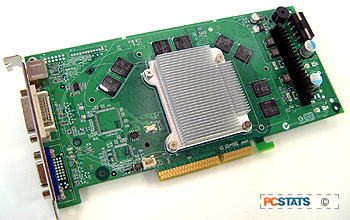Beginners Guide: Flashing a Video Card BIOS
While this *not* something for the novice to undertake, flashing your video card BIOS may lead to performance and feature enhancements. - Version
1.0.2
We recently ran an article on
flashing (reprogramming)
the BIOS (Basic Input/Output System) of your motherboard to enable
new features and fix errors. That got us thinking that we'd only covered half
the story. Sure, hardware enthusiasts have been upgrading the BIOS on their
motherboards for years, but what about the other components of a computer
system?
Video cards in particular have
an interesting history in relation to the BIOS flashing procedure. While
motherboard BIOS fixes generally add support for new processors and fix hardware
glitches, video card BIOS updates have the potential to do much more.
Enterprising tech-heads have discovered instances where a video card can
actually be transformed by a BIOS update, activating hidden features and
potential buried performance aspects by the manufacturer (generally for
marketing purposes) .
In this article, PCstats will
describe the process of flashing (re-programming) your video card's BIOS chip.
We cover the potential benefits and risks of the procedure, as well as specific
steps for both ATI and Nvidia cards. In case anything goes wrong, a
troubleshooting section brings up the rear, and may save yours.
 What Does A Video Card BIOS
Do?
What Does A Video Card BIOS
Do?
Before an Operating system
like Windows XP loads and the
software drivers take control of your video card's functions, the video BIOS
initializes the card. As soon as it receives power from the motherboard, the
BIOS activates the card and identifies itself to the motherboard BIOS.
At this point, the graphic
processor and video memory clock speeds are also set by the BIOS, though these
may be overridden by the drivers or other utilities once the operating system
has loaded.
In short, the video BIOS
starts and identifies the card, and provides its initial crop of settings.
In the current age of the
unified video driver, where manufacturers like ATI and Nvidia provide a single set of drivers for all their video
products, the way the video drivers interact with a card also depends on how the
card is identified by the BIOS. Thus, 'new' features can be activated by using a
different BIOS on the same Graphics processor.
 Why Flash It?
Why Flash It?
Well, there are several good
reasons to flash your video card's BIOS. For one thing, some manufacturers have
and will release BIOS updates for their video cards, though this has become
considerably rarer in the last few years. These updates may increase the
stability of the card, eliminate glitches and problems, and possibly increase
performance. A more compelling reason is the lure of getting your video card to
perform to its maximum possible potential.
Video card manufacturers have
been known to create artificial product divisions, whereby the same model of
Graphics processor is packaged with different memory and BIOS settings to create
a higher end and lower end version of what is essentially the same item. As the
video BIOS governs the speeds the GPU and memory can be set to, changing this
can have a huge effect on video card performance and overclockability.
The same graphics processor
can be set to run at a lower speed so that the company can have entry level and
high-end versions of the same part without the expense of commissioning two
different graphics core designs.
 A good recent example of this
sort of thing is with ATI's Radeon 9800 PRO and Radeon XT cards. Many 256MB 9800
Pro cards (and some 128MB ones too) actually use the same graphics processor
core as the 'faster' and more feature laden 9800 XT cards. A simple BIOS flash
will increase the speed of the card and enable features that were not previously
available to the 9800Pro, like temperature monitoring and the 'overdrive' driver
overclocking option.
A good recent example of this
sort of thing is with ATI's Radeon 9800 PRO and Radeon XT cards. Many 256MB 9800
Pro cards (and some 128MB ones too) actually use the same graphics processor
core as the 'faster' and more feature laden 9800 XT cards. A simple BIOS flash
will increase the speed of the card and enable features that were not previously
available to the 9800Pro, like temperature monitoring and the 'overdrive' driver
overclocking option.
Please note that this is a
possibility specific to the one type of video card only, and cannot be
duplicated with other products. Similar processes exist for various other types
of video cards though. A quick bit of research on the Internet will turn up many
accounts of this.
It's fair to note at this
point that many of the gains achieved by successfully flashing a new BIOS onto
your card can be directly attributed to the new BIOS increasing the GPU and
memory speeds. These gains can also be realized with overclocking, at less risk
to the card. What cannot be duplicated though, are the addition of new features
and the sheer pleasure of seeing your video card identified as a model that
costs $100 more.

